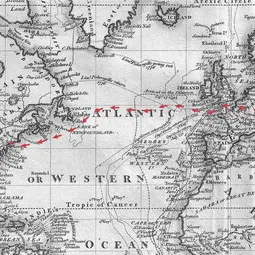Climate changes triggered immigration to America in the 19th century
From Trump to Heinz, some of America’s most famous family names and brands trace their origins back to Germans who emigrated to the country in the 19th century. Researchers from the University of Freiburg have now found that climate was a major factor in driving migration from Southwest Germany to North America during the 19th century. The results are published today in Climate of the Past, a journal of the European Geosciences Union.
In the 19th century, over 5 million Germans moved to North America. It was not only a century of poverty, war and revolutions in what is now Germany, but also of variable climate. Starting at the tail end of the cold period known as the Little Ice Age, the century saw glacier advances in the Alps, and a number of chilly winters and cool summers, as well as other extreme weather events such as droughts and floods.
“Overall, we found that climate indirectly explains up to 20-30% of migration from Southwest Germany to North America in the 19th century,” says Rüdiger Glaser, a professor at the University of Freiburg, Germany, and lead-author of the Climate of the Past study.
The researchers could see a climate signature in most major migration waves from Southwest Germany during the 19th century. “The chain of effects is clearly visible: poor climate conditions lead to low crop yields, rising cereal prices and finally emigration,” says Glaser. “But it is only one piece of the puzzle.”
“Our results show that the influence of climate was marked differently during the different migration waves,” adds Iso Himmelsbach, another of the researchers at the University of Freiburg who took part in the study.
The team studied official migration statistics and population data from the 19th century, as well as weather data, harvest figures and cereal-price records. They focused on the region that is now the Baden-Württemberg state, where many of the migrants – such as Charles Pfizer of pharmaceutical fame – originated from. They started by identifying the major migration waves and then investigated to what extent climate played a role in driving people to North America during each of them.
The first wave followed the eruption of the Tambora volcano in Indonesia in 1815. The volcanic ash and gases spewed into the atmosphere caused temperatures to drop around the world for a few years after the eruption. The ‘year without summer’, 1816, was wet and cold causing widespread crop failures, famine and emigration.
“Another peak-migration year, 1846, had an extremely hot and dry summer leading to bad harvests and high food prices,” says Annette Bösmeier, a researcher at the University of Freiburg who also involved in the study. “These two years of high migration numbers appear to be quite strongly influenced by climate changes, while for other migration waves other circumstances appeared to be more important,” she adds.
Climate was a less significant factor in driving the largest emigration wave, from 1850 to 1855, the researchers found. While unfavourable weather affected crops resulting in low harvests during this time, other factors also drove up food prices. During the Crimean War (1853–1856), for example, France banned food exports, putting pressure on the German grain markets. At the time, the authorities of Baden also paid the poorest people to leave the country in an attempt to prevent uprisings and save on welfare. This, too, drove up emigration numbers.
“Migration in the 19th century was a complex process influenced by multiple factors. Lack of economic perspectives, social pressure, population development, religious and political disputes, warfare, family ties and the promotion of emigration from different sides influenced people’s decision to leave their home country,” concludes Glaser. “Nevertheless, we see clearly that climate was a major factor.”
In the past few years, climate has taken a central stage in migration discussions since future climate change is expected to lead to mass migration (‘climate refugees’), as sea levels rise and extreme weather events, such as floods, droughts and hurricanes, become more frequent. The team hope their study can shed some light on the various factors influencing migration and how important climate can be in triggering mass movements of people.
###
Please mention the name of the publication (Climate of the Past) if reporting on this story and, if reporting online, include a link to the paper (https://www.clim-past.net/13/1573/2017) or to the journal website (https://www.climate-of-the-past.net).
More information
This research is presented in the paper ‘Climate of migration? How climate triggered migration from Southwest Germany into North America during the 19th century’ published in the EGU open access journal Climate of the Past on 21 November 2017.
The study was part of the project Climates of Migration, which was funded by the German federal Ministry of Education and Research (12/2010–06/2014) which was a common project of The Rachel Carson Center for Environment and Society, Munich and the Institute for Advanced Study in the Humanities, Essen (KWI).
Glaser, R., Himmelsbach, I., and Bösmeier, A.: Climate of migration? How climate triggered migration from southwest Germany to North America during the 19th century, Clim. Past, 13, 1573–1592, https://doi.org/10.5194/cp-13-1573-2017, 2017
The team is composed of Rüdiger Glaser, Iso Himmelsbach, and Annette Boesmeier (Physical Geography, University of Freiburg, Germany).
The European Geosciences Union (EGU) is Europe’s premier geosciences union, dedicated to the pursuit of excellence in the Earth, planetary, and space sciences for the benefit of humanity, worldwide. It is a non-profit interdisciplinary learned association of scientists founded in 2002 with headquarters in Munich, Germany. The EGU has a current portfolio of 17 diverse scientific journals, which use an innovative open access format, and organises a number of topical meetings, and education and outreach activities. Its annual General Assembly is the largest and most prominent European geosciences event, attracting over 13,000 scientists from all over the world. The meeting’s sessions cover a wide range of topics, including volcanology, planetary exploration, the Earth’s internal structure and atmosphere, climate, energy, and resources. The EGU 2018 General Assembly is taking place in Vienna, Austria, from 8 to 13 April 2018. For more information and press registration, please check http://media.egu.eu closer to the time of the meeting, or follow the EGU on Twitter and Facebook.
If you wish to receive our press releases via email, please use the Press Release Subscription Form at http://www.egu.eu/news/subscribe/. Subscribed journalists and other members of the media receive EGU press releases under embargo (if applicable) at least 24 hours in advance of public dissemination.
Climate of the Past (CP) is an international scientific journal dedicated to the publication and discussion of research articles, short communications, and review papers on the climate history of the Earth. CP covers all temporal scales of climate change and variability, from geological time through to multidecadal studies of the last century. Studies focusing mainly on present and future climate are not within scope.
Contact
Scientists
Rüdiger Glaser
Professor and Managing Director of the Institute of Physical Geography
University of Freiburg, Germany
Phone +49(0)761-203-3527
Email ruediger.glaser@geographie.uni-freiburg.de
Iso Himmelsbach
Researcher, Institute of Physical Geography
University of Freiburg, Germany
Phone +49(0)761-203-3552
Email iso.himmelsbach@geographie.uni-freiburg.de
Annette Bösmeier
Researcher, Institute of Physical Geography
University of Freiburg, Germany
Phone +49(0)761-203-9124
Email annette.boesmeier@geographie.uni-freiburg.de
Press officers
Bárbara Ferreira
EGU Media and Communications Manager
Munich, Germany
Phone +49-89-2180-6703
Email media@egu.eu
EGU on Twitter: @EuroGeosciences
Public Relations
University of Freiburg
Phone (+49) 0761 203 4302
Email info@pr.uni-freiburg.de
Links
- Scientific paper
- Journal – Climate of the Past
- Read this press release in simplified language, aimed at 7–13 year olds, on our Planet Press site




